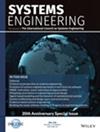Effects of individual strategies for resource access on collaboratively maintained irrigation infrastructure
IF 1.6
3区 工程技术
Q4 ENGINEERING, INDUSTRIAL
引用次数: 0
Abstract
Built infrastructure for water and energy supply, transportation, and other such services underpins human well‐being and socioeconomic development. A fundamental understanding of how infrastructure design and user strategies interact can guide important design decisions as well as policy formulation for ensuring long‐term infrastructure viability in conjunction with improved individual user benefits. In this work, an agent based model (ABM) is developed to study this issue for the specific case of irrigation canals. Cooperatively maintained irrigation canals serve essential roles in sustaining agriculture‐based economies in many regions. Canal system design can strongly affect benefits derived by distributed users, regional agricultural output, and the long‐term viability of the shared infrastructure itself. Here, an ABM is used to investigate how an option to use an independent water source interacts with canal design to affect canal maintenance cooperation and farmer income. The independent water source is stylized as a well that provides access to groundwater and represents a strategically robust design option; a design option that reduces the implementer's utility vulnerability to unfavorable actions by other actors. Research in other systems has demonstrated that strategically robust designs can improve both implementer utility and the probability of collaboration. The results of this research, in contrast, demonstrate that the option of individual resource access, the strategically robust design option, as represented by a well, reduces cooperative maintenance in most cases. However, wells also improve farmer income, especially for downstream farmers that are most affected by water theft.资源获取的个别策略对协同维护的灌溉基础设施的影响
本文章由计算机程序翻译,如有差异,请以英文原文为准。
求助全文
约1分钟内获得全文
求助全文
来源期刊

Systems Engineering
工程技术-工程:工业
CiteScore
5.10
自引率
20.00%
发文量
0
审稿时长
6 months
期刊介绍:
Systems Engineering is a discipline whose responsibility it is to create and operate technologically enabled systems that satisfy stakeholder needs throughout their life cycle. Systems engineers reduce ambiguity by clearly defining stakeholder needs and customer requirements, they focus creativity by developing a system’s architecture and design and they manage the system’s complexity over time. Considerations taken into account by systems engineers include, among others, quality, cost and schedule, risk and opportunity under uncertainty, manufacturing and realization, performance and safety during operations, training and support, as well as disposal and recycling at the end of life. The journal welcomes original submissions in the field of Systems Engineering as defined above, but also encourages contributions that take an even broader perspective including the design and operation of systems-of-systems, the application of Systems Engineering to enterprises and complex socio-technical systems, the identification, selection and development of systems engineers as well as the evolution of systems and systems-of-systems over their entire lifecycle.
Systems Engineering integrates all the disciplines and specialty groups into a coordinated team effort forming a structured development process that proceeds from concept to realization to operation. Increasingly important topics in Systems Engineering include the role of executable languages and models of systems, the concurrent use of physical and virtual prototyping, as well as the deployment of agile processes. Systems Engineering considers both the business and the technical needs of all stakeholders with the goal of providing a quality product that meets the user needs. Systems Engineering may be applied not only to products and services in the private sector but also to public infrastructures and socio-technical systems whose precise boundaries are often challenging to define.
 求助内容:
求助内容: 应助结果提醒方式:
应助结果提醒方式:


